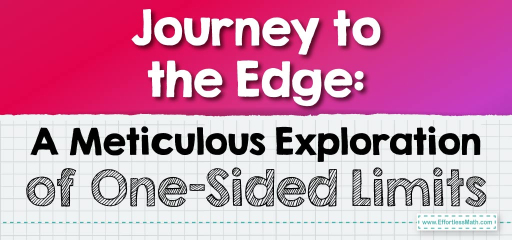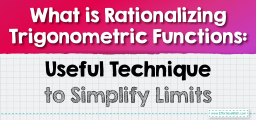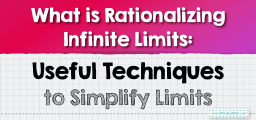Journey to the Edge: A Meticulous Exploration of One-Sided Limits
Within the vast expanse of calculus, one encounters numerous phenomena that reveal the enigmatic nature of mathematical functions. Among these, the concept of one-sided limits emerges as a tantalizing challenge. This guide, intricately woven and meticulously designed, serves as your compass in this pursuit, helping you delve deep into the arcane intricacies of approaching function values from one side alone.

Step-by-step Guide to Understanding One-Sided Limits
Here is a step-by-step guide to understanding one-sided limits:
Step 1: Establishing the Foundational Premise
Premise: A one-sided limit focuses on the behavior of a function as its input approaches a specific point exclusively from one direction, either from the left or from the right.
Step-by-Step:
- Visual Initiation: Start by graphing the function. This visual representation provides invaluable insights into the landscape of the function, especially around points of interest.
- Demarcating Directionality:
- Left-hand Limit (denoted \(lim_{x→c^−}f(x)\)): Investigates the behavior as \(x\) approaches \(c\) from values less than \(c\).
- Right-hand Limit (denoted \(lim_{x→c^+}f(x)\)): Focuses on the function’s behavior as \(x\) approaches \(c\) from values greater than \(c\).
- Analytical Approach:
- Substitute values increasingly close to \(c\) from the chosen direction. Monitor how \(f(x)\) behaves as \(x\) gets tantalizingly close to \(c\) from that side.
Step 2: Encountering Ambiguities & Resolving Them
- Encounter with Discontinuities: The graph may reveal jumps, holes, or asymptotic behaviors. These are often the points where one-sided limits are most relevant.
- Indeterminate Forms: If approaching the point results in forms like \(0/0\) or \(∞/∞\), further analysis is needed.
- Techniques like factoring, rationalizing, or applying L’Hopital’s rule (when appropriate) can be employed.
- Piecewise Functions: Given their nature, piecewise functions can have differing behaviors on either side of a given point. It’s vital to identify which segment of the function to analyze based on the direction of the approach.
Step 3: Inferring from One-Sided Limits
- Deduction of Continuity: If both one-sided limits at a point exist, are finite, and are equal, the two-sided limit exists and equals that common value. This, combined with a defined function value at that point, can imply continuity.
- Existence Does Not Imply Equality: Remember, a function can have existing left and right limits at a point without those limits being equal. Such points often highlight jumps or other non-continuous behaviors.
Final Word:
Embarking on the quest to fathom one-sided limits offers a nuanced perspective on the intricate dance of functions around specific points. It’s akin to understanding the whispers of a tale told from two different viewpoints. With this guide in hand, may your exploration be filled with profound insights, revelations, and an enriched appreciation for the mesmerizing nuances of mathematical functions.
Example:
\(g(x)=\) \(\begin{cases} \
2x-1 \ if \ x<3, \\
-x+6 \ if \ x≥3\end{cases}\)
Determine the one-sided limits as \( x \) approaches \(3\).
Solution:
1. Left-hand limit (as \( x \) approaches \(3\) from the left):
\[ \lim_{{x \to 3^-}} g(x) = \lim_{{x \to 3^-}} (2x – 1) \]
Substituting \( x = 3 \), we get:
\[ = 2(3) – 1 = 5 \]
2. Right-hand limit (as \( x \) approaches \(3\) from the right):
\[ \lim_{{x \to 3^+}} g(x) = \lim_{{x \to 3^+}} (-x + 6) \]
Substituting \( x = 3 \), we get: \[ = -3 + 6 = 3 \]
Thus, the left-hand limit is \(5\), while the right-hand limit is \(3\). The two limits are different; hence, the overall limit at \( x = 3 \) does not exist for the function \( g(x) \).
Related to This Article
More math articles
- Counting the Change: How to Master the Subtraction of Money Amounts
- FREE 3rd Grade FSA Math Practice Test
- FREE 4th Grade MEAP Math Practice Test
- How to Transform Linear Functions
- 7th Grade FSA Math Worksheets: FREE & Printable
- 5 Tips for Surviving a Statistics Course
- Transformation Using Matrices
- 5th Grade ILEARN Math Worksheets: FREE & Printable
- Complete Guide to Foundational Vector Operations: Addition, Scaling, and More
- How to Measure Angles with a Protractor


























What people say about "Journey to the Edge: A Meticulous Exploration of One-Sided Limits - Effortless Math: We Help Students Learn to LOVE Mathematics"?
No one replied yet.